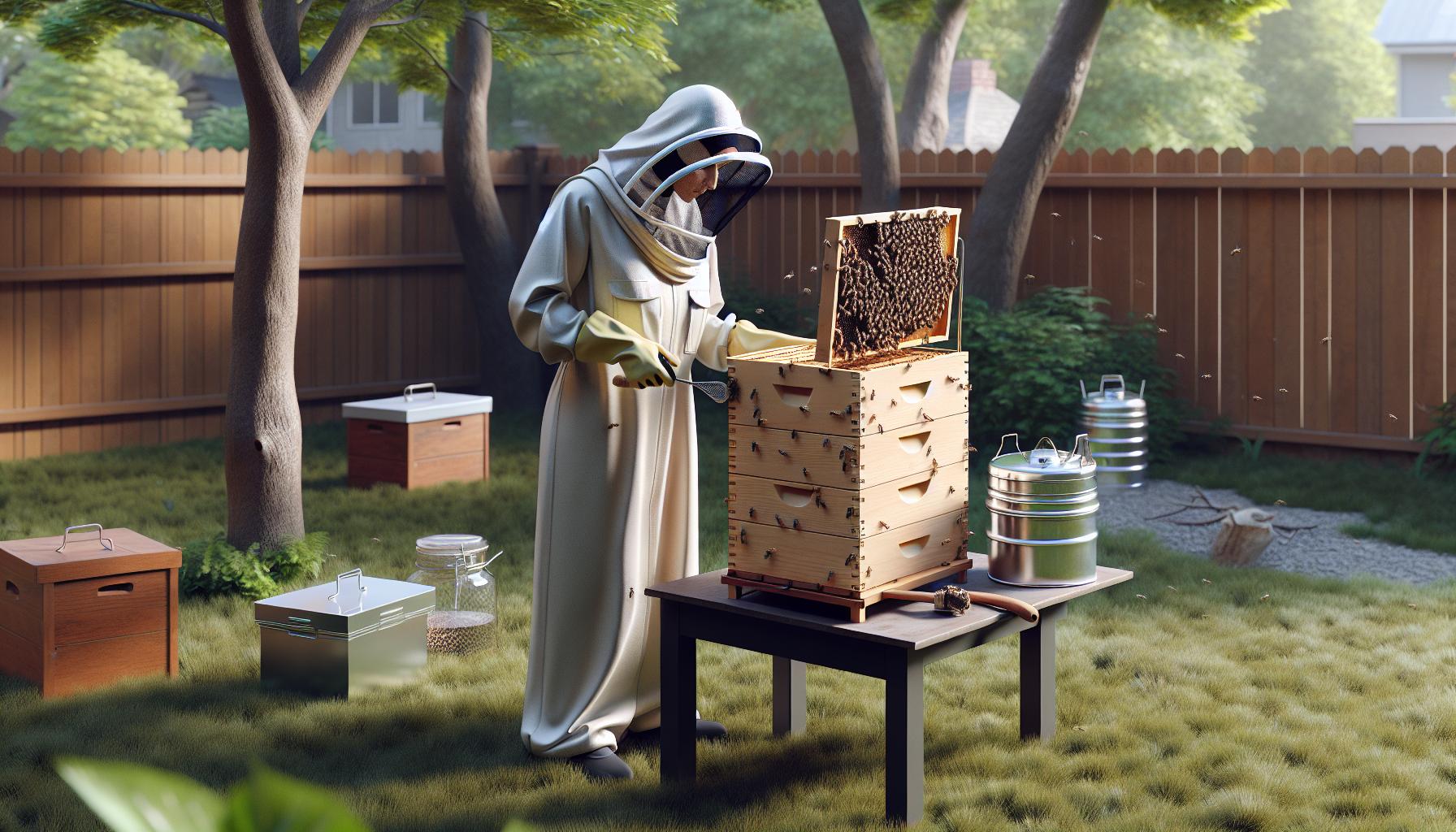When bees decide to build a hive in your backyard, attic, or walls, it can create a stressful situation for homeowners. While bees play a crucial role in pollination and environmental health, their presence in or near residential areas can pose safety risks. Knowing how to handle bee hive removal is essential for ensuring both human safety and the preservation of these important pollinators.
In this guide, we’ll explore the best practices for bee hive removal, the importance of professional services, cost considerations, and essential safety precautions. Additionally, we’ll address some of the most frequently asked questions about the process.
Understanding Bee Hive Removal
Bee hive removal is a necessary step for protecting your home and ensuring safety. However, it is crucial to handle the process correctly to prevent harm to both humans and bees. Professional removal services use safe and humane techniques to relocate bees rather than exterminating them, which helps maintain ecological balance.
Why Professional Removal Matters
Professional bee hive removal services provide expertise in identifying bee species, assessing the hive's size and location, and executing safe relocation methods. These experts use specialized equipment and knowledge to ensure minimal disruption to both the bees and homeowners. Additional benefits of hiring professionals include:
-
Reduced Risk of Stings: Professionals have protective gear and experience in handling bees safely.
-
Preservation of Bee Colonies: Relocating hives rather than exterminating them supports environmental conservation.
-
Thorough Inspection and Prevention: Many services offer follow-up inspections to ensure bees do not return.
By choosing a reputable bee removal service, homeowners can avoid unnecessary risks while ensuring the well-being of local bee populations.
Dangers of DIY Bee Hive Removal
Many homeowners consider DIY bee removal methods, but these approaches can be dangerous and ineffective. Some common risks include:
-
Increased Aggression: Disturbing a hive improperly can provoke defensive behavior, leading to multiple stings.
-
Property Damage: Attempting removal without proper techniques can damage walls, ceilings, or outdoor structures.
-
Failure to Remove the Entire Hive: Leaving behind parts of the hive, such as honeycomb or larvae, can attract more bees or pests.
DIY removal methods are not only risky but often result in recurring problems. Seeking professional assistance is the safest and most effective way to address bee infestations.
Finding Local Bee Hive Removal Services
If you have a bee hive on your property, finding a reliable removal service is essential. Here’s how to locate the best professionals in your area:
Searching for a Removal Service
-
Online Searches: Use search terms like “bee hive removal near me” to find local services.
-
Community Boards and Groups: Local forums, social media groups, and neighborhood associations often have recommendations.
-
Referrals: Ask friends, neighbors, or local beekeeping organizations for trusted service providers.
Choosing the Right Service Provider
When selecting a bee hive removal service, consider the following factors:
-
Experience and Expertise: Look for companies with a proven track record in safe bee relocation.
-
Certifications and Licenses: Ensure the service provider holds relevant pest control and beekeeping certifications.
-
Humane Removal Methods: Choose a company that prioritizes relocation over extermination.
-
Customer Reviews: Check online reviews and testimonials to gauge service quality.
-
Follow-Up Services: Opt for services that offer inspections and preventative measures to keep bees from returning.
Selecting a well-reviewed, experienced provider ensures a smooth and effective removal process.
Cost Considerations for Bee Hive Removal
The cost of bee hive removal varies depending on several factors. Understanding these variables can help homeowners budget appropriately.
Factors Affecting Cost
-
Location: Urban areas may have higher costs due to accessibility challenges, while rural locations might have fewer service providers.
-
Hive Size and Complexity: Larger hives require more effort and resources, increasing the price.
-
Bee Species: Some species, such as Africanized bees, require specialized handling, which can affect costs.
-
Time of Year: Peak bee activity during spring and summer may lead to higher demand and pricing.
-
Removal Method: Humane relocation services may cost more than extermination due to additional efforts in safely transferring the hive.
Insurance and Warranty Considerations
-
Liability Insurance: Ensure the company carries insurance to cover potential damages or injuries.
-
Service Guarantees: Many services offer warranties, meaning if bees return within a specific timeframe, they will address the issue at no extra cost.
Understanding these cost factors allows homeowners to make informed decisions when hiring a removal service.
Safety Precautions for Bee Hive Removal
Ensuring safety during bee hive removal is critical. Whether hiring professionals or preparing for their arrival, these precautions can minimize risks.
Preparing for Hive Removal
-
Keep a Safe Distance: Avoid disturbing the hive until professionals arrive.
-
Wear Protective Gear: If close proximity is necessary, wear long sleeves, gloves, and a bee veil.
-
Inform Neighbors: Alert those nearby, especially if they have allergies to bee stings.
-
Keep Pets and Children Indoors: Prevent unnecessary exposure to potential stings.
-
Avoid Using Pesticides: Spraying chemicals can agitate the bees and make professional removal more difficult.
Post-Removal Care
-
Inspect for Remaining Bees: Some stragglers may linger, so check the area after removal.
-
Seal Entry Points: Prevent future infestations by sealing holes or cracks where bees entered.
-
Clean the Area: Remove traces of honeycomb and hive materials to avoid attracting new colonies.
-
Monitor the Location: Watch for signs of returning bees and contact professionals if necessary.
Following these steps helps prevent future infestations and ensures a successful removal process.
Conclusion
Dealing with a bee hive on your property requires careful planning and professional assistance. Hiring expert removal services ensures a safe and effective solution that protects both homeowners and the bee population. By choosing humane relocation methods, homeowners contribute to ecological preservation while safeguarding their homes.
If you encounter a bee hive on your property, act promptly, research local removal services, and prioritize safety throughout the process. With the right approach, you can successfully resolve the issue while supporting environmental sustainability.
Frequently Asked Questions
1. What are the risks of leaving a bee hive untreated?
If a hive is left undisturbed, it can continue to grow, leading to increased risks of stings, property damage, and potential structural issues if built within walls or ceilings. Additionally, abandoned hives can attract pests like ants, moths, and rodents.
2. How long does the removal process take?
The time required depends on the size and location of the hive. Small, accessible hives may take under an hour to remove, while larger or more complex hives within structures can require multiple visits.
3. Can I relocate a bee hive myself?
Unless you have experience in beekeeping, it’s not recommended to attempt relocation on your own. Improper handling can provoke bees, resulting in stings and possible reinfestation if the hive isn’t completely removed.
4. How do professionals prevent bees from returning?
Professional removal services typically seal entry points, clean the hive area thoroughly, and may use deterrents to prevent bees from re-establishing a colony in the same location.
5. What should I do if I notice bees returning after removal?
If bees return, inspect for remaining hive remnants or entry points that were not sealed. Contact the removal service for a follow-up inspection to address the issue.



